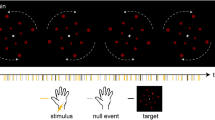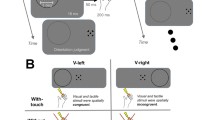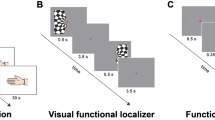Abstract
In the context of the Touch-Hapsys project, our group investigated whether the two main components of the cortical visual systems, i.e., the ventral ”what” pathway and the dorsal ”where” pathways, are devoted merely to the processing of visual information or rather they are organized in a supramodal fashion, that is, they are able to process information independently from the sensory modality through which such an information reaches the brain. Sighted and congenitally blind individuals underwent fMRI scan examinations while performing distinct visual and/or tactile experimental tasks involving object recognition, movement detection and spatial localization. These functional studies revealed that both sighted subjects and individuals with no previous visual experience rely on these supramodal brain areas of the ventral and dorsal extrastriate cortex to acquire normal knowledge about objects and interact effectively with the surrounding world.
Access this chapter
Tax calculation will be finalised at checkout
Purchases are for personal use only
Preview
Unable to display preview. Download preview PDF.
Similar content being viewed by others
References
Amedi, A., Floel, A., Knecht, S., Zohary, E., Cohen, L.G.: Transcranial magnetic stimulation of the occipital pole interferes with verbal processing in blind subjects. Nat. Neurosci. 7, 1266–1270 (2004)
Amedi, A., Jacobson, G., Hendler, T., Malach, R., Zohary, E.: Convergence of visual and tactile shape processing in the human lateral occipital complex. Cereb Cortex 12, 1202–1212 (2002)
Amedi, A., Malach, R., Hendler, T., Peled, S., Zohary, E.: Visuo-haptic object-related activation in the ventral visual pathway. Nat. Neurosci. 4, 324–330 (2001)
Bicchi, A., De Rossi, D., Scilingo, E.P.: The role of the contact area spread rate in haptic discrimination of softness. IEEE trans. on Robotics and Automation 16, 496–504 (2000)
Blake, R., Sobel, K.V., James, T.W.: Neural synergy between kinetic vision and touch. Psychol Sci. 15, 397–402 (2004)
Burton, H., McLaren, D.G., Sinclair, R.J.: Reading embossed capital letters: An fMRI study in blind and sighted individuals. Human Brain Mapping (2005)
Cohen, L.G., Celnik, P., Pascual-Leone, A., Corwell, B., Falz, L., Dambrosia, J., Honda, M., Sadato, N., Gerloff, C., Catala, M.D., Hallett, M.: Functional relevance of cross-modal plasticity in blind humans. Nature 389, 180–183 (1997)
Cohen, L.G., Weeks, R.A., Sadato, N., Celnik, P., Ishii, K., Hallett, M.: Period of susceptibility for cross-modal plasticity in the blind. Ann. Neurol 45, 451–460 (1999)
Cornoldi, C., Cortesi, A., Preti, D.: Individual differences in the capacity limitations of visuospatial short-term memory: research on sighted and totally congenitally blind people. Mem. Cognit. 19, 459–468 (1991)
Goebel, R., Khorram-Sefar, D., Muckli, L., Hacker, H., Singer, W.: The constructive nature of vision: direct evidence from functional magnetic resonance imaging studies of apparent motion and motion imagery. Eur. J. Neurosci. 10, 1563–1573 (1998)
Hagen, M.C., Franzen, O., McGlone, F., Essick, G., Dancer, C., Pardo, J.V.: Tactile motion activates the human middle temporal/V5 (MT/V5) complex. Eur. J. Neurosci. 16, 957–964 (2002)
Haxby, J.V., Gobbini, M.I., Furey, M.L., Ishai, A., Schouten, J.L., Pietrini, P.: Distributed and overlapping representations of faces and objects in ventral temporal cortex. Science 293, 2425–2430 (2001)
Huk, A.C., Dougherty, R.F., Heeger, D.J.: Retinotopy and functional subdivision of human areas MT and MST. J. Neurosci. 22, 7195–7205 (2002)
Ishai, A., Ungerleider, L.G., Haxby, J.V.: Distributed neural systems for the generation of visual images. Neuron 28, 979–990 (2000)
Kilgour, A.R., Kitada, R., Servos, P., James, T.W., Lederman, S.J.: Haptic face identification activates ventral occipital and temporal areas: an fMRI study. Brain Cogn. 59, 246–257 (2005)
Klein, I., Dubois, J., Mangin, J.F., Kherif, F., Flandin, G., Poline, J.B., Denis, M., Kosslyn, S.M., Le Bihan, D.: Retinotopic organization of visual mental images as revealed by functional magnetic resonance imaging. Brain Res. Cogn. Brain Res. 22, 26–31 (2004)
Kosslyn, S.M., Pascual-Leone, A., Felician, O., Camposano, S., Keenan, J.P., Thompson, W.L., Ganis, G., Sukel, K.E., Alpert, N.M.: The role of area 17 in visual imagery: convergent evidence from PET and rTMS. Science 284, 167–170 (1999)
Kourtzi, Z., Bulthoff, H.H., Erb, M., Grodd, W.: Object-selective responses in the human motion area MT/MST. Nat. Neurosci. 5, 17–18 (2002)
Kourtzi, Z., Kanwisher, N.: Activation in human MT/MST by static images with implied motion. J. Cogn. Neurosci. 12, 48–55 (2000)
Kreiman, G., Koch, C., Fried, I.: Imagery neurons in the human brain. Nature 408, 357–361 (2000)
Lambert, S., Sampaio, E., Mauss, Y., Scheiber, C.: Blindness and brain plasticity: contribution of mental imagery? An fMRI study. Brain Res. Cogn. Brain Res. 20, 1–11 (2004)
Malach, R., Reppas, J.B., Benson, R.R., Kwong, K.K., Jiang, H., Kennedy, W.A., Ledden, P.J., Brady, T.J., Rosen, B.R., Tootell, R.B.: Object-related activity revealed by functional magnetic resonance imaging in human occipital cortex. Proc. Natl. Acad. Sci. U.S.A. 92, 8135–8139 (1995)
Morrone, M.C., Tosetti, M., Montanaro, D., Fiorentini, A., Cioni, G., Burr, D.C.: A cortical area that responds specifically to optic flow, revealed by fMRI. Nat. Neurosci. 3, 1322–1328 (2000)
Muckli, L., Kriegeskorte, N., Lanfermann, H., Zanella, F.E., Singer, W., Goebel, R.: Apparent motion: event-related functional magnetic resonance imaging of perceptual switches and States. J. Neurosci. 22, RC219 (2002)
Pietrini, P., Furey, M.L., Ricciardi, E., Gobbini, M.I., Wu, W.H., Cohen, L., Guazzelli, M., Haxby, J.V.: Beyond sensory images: Object-based representation in the human ventral pathway. Proc. Natl. Acad. Sci. U.S.A. 101, 5658–5663 (2004)
Poirier, C., Collignon, O., Scheiber, C., Renier, L., Vanlierde, A., Tranduy, D., Veraart, C., De Volder, A.G.: Auditory motion perception activates visual motion areas in early blind subjects. Neuroimage (2006)
Prather, S.C., Votaw, J.R., Sathian, K.: Task-specific recruitment of dorsal and ventral visual areas during tactile perception. Neuropsychologia 42, 1079–1087 (2004)
Raichle, M.E.: Functional brain imaging and human brain function. J. Neurosci. 23, 3959–3962 (2003)
Reed, C.L., Klatzky, R.L., Halgren, E.: What vs. where in touch: an fMRI study. Neuroimage 25, 718–726 (2005)
Ricciardi, E., Bonino, D., Gentili, C., Sani, L., Pietrini, P., Vecchi, T.: Neural correlates of spatial working memory in humans: a functional magnetic resonance imaging study comparing visual and tactile processes. Neuroscience 139, 339–349 (2006)
Ricciardi, E., Vanello, N., Sani, L., Gentili, C., Scilingo, E.P., Landini, L., Guazzelli, M., Bicchi, A., Haxby, J.V., Pietrini, P.: The Effect of Visual Experience on the Development of Functional Architecture in hMT+ Cereb Cortex [Epub ahead of print] (2007)
Sadato, N.: How the blind ”see” Braille: lessons from functional magnetic resonance imaging. Neuroscientist 11, 577–582 (2005)
Sadato, N., Okada, T., Honda, M., Yonekura, Y.: Critical period for cross-modal plasticity in blind humans: a functional MRI study. Neuroimage 16, 389–400 (2002)
Sadato, N., Pascual-Leone, A., Grafman, J., Ibanez, V., Deiber, M.P., Dold, G., Hallett, M.: Activation of the primary visual cortex by Braille reading in blind subjects. Nature 380, 526–528 (1996)
Sathian, K., Zangaladze, A.: Feeling with the mind’s eye: contribution of visual cortex to tactile perception. Behav. Brain Res. 135, 127–132 (2002)
Tootell, R.B., Reppas, J.B., Dale, A.M., Look, R.B., Sereno, M.I., Malach, R., Brady, T.J., Rosen, B.R.: Visual motion aftereffect in human cortical area MT revealed by functional magnetic resonance imaging. Nature 375, 139–141 (1995)
Tootell, R.B., Taylor, J.B.: Anatomical evidence for MT and additional cortical visual areas in humans. Cereb Cortex 5, 39–55 (1995)
Ungerleider, L.G., Haxby, J.V.: What and where in the human brain. Curr. Opin. Neurobioll. 4, 157–165 (1994)
Vanlierde, A., De Volder, A.G., Wanet-Defalque, M.C., Veraart, C.: Occipito-parietal cortex activation during visuo-spatial imagery in early blind humans. Neuroimage 19, 698–709 (2003)
Vecchi, T., Monticellai, M.L., Cornoldi, C.: Visuo-spatial working memory: structures and variables affecting a capacity measure. Neuropsychologia 33, 1549–1564 (1995)
De Volder, A.G., Toyama, H., Kimura, Y., Kiyosawa, M., Nakano, H., Vanlierde, A., Wanet-Defalque, M.C., Mishina, M., Oda, K., Ishiwata, K., Senda, M.: Auditory triggered mental imagery of shape involves visual association areas in early blind humans. Neuroimage 14, 129–139 (2001)
Weeks, R., Horwitz, B., Aziz-Sultan, A., Tian, B., Wessinger, C.M., Cohen, L.G., Hallett, M., Rauschecker, J.P.: A positron emission tomographic study of auditory localization in the congenitally blind. J. Neurosci. 20, 2664–2672 (2000)
Weisser, V., Stilla, R., Peltier, S., Hu, X., Sathian, K.: Short-term visual deprivation alters neural processing of tactile form. Exp. Brain Res. 166, 572–582 (2005)
Zhang, M., Mariola, E., Stilla, R., Stoesz, M., Mao, H., Hu, X., Sathian, K.: Tactile discrimination of grating orientation: fMRI activation patterns. Hum. Brain Mapp. 25, 370–377 (2005)
Author information
Authors and Affiliations
Editor information
Rights and permissions
Copyright information
© 2008 Springer-Verlag Berlin Heidelberg
About this chapter
Cite this chapter
Ricciardi, E., Bonino, D., Sani, L., Pietrini, P. (2008). Functional Exploration Studies of Supramodal Organization in the Human Extrastriate Cortex. In: Bicchi, A., Buss, M., Ernst, M.O., Peer, A. (eds) The Sense of Touch and its Rendering. Springer Tracts in Advanced Robotics, vol 45. Springer, Berlin, Heidelberg. https://doi.org/10.1007/978-3-540-79035-8_2
Download citation
DOI: https://doi.org/10.1007/978-3-540-79035-8_2
Publisher Name: Springer, Berlin, Heidelberg
Print ISBN: 978-3-540-79034-1
Online ISBN: 978-3-540-79035-8
eBook Packages: EngineeringEngineering (R0)




